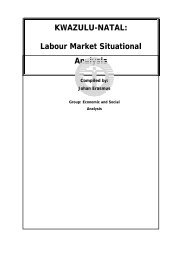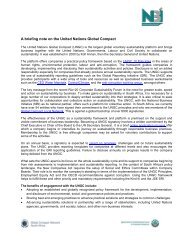Sustainable Forest Finance Toolkit - PwC
Sustainable Forest Finance Toolkit - PwC
Sustainable Forest Finance Toolkit - PwC
- No tags were found...
You also want an ePaper? Increase the reach of your titles
YUMPU automatically turns print PDFs into web optimized ePapers that Google loves.
Suggested Internal Bank <strong>Forest</strong>ryPolicy and Guidelines3 of 4Policy Dev HOMEComponent Description of Component Content Options Reflecting Good PracticePolicyimplementation andtransparencyA description of:• the availability of the policy inthe public domain,• the role of external stakeholdersin policy development andreview processes going forward,• the governance andaccountability mechanisms inplaceOverarching policy implementation principles and guidance1. Demonstrating commitmentThe Board of Directors of the bank will be committed to ensure that compliance with the sustainable forest financing policy is achieved by the entireorganisation of the bank. All exceptions to the policy should be approved by Environmental and Social Risk Assessment and a member of the Board ofDirectors.2. Assigning responsibility and accountabilityThe accountability for the implementation and monitoring of the policy will be the responsibility of a designated member of the bank’s Board of Directors.3. TransparencyThe bank should consider the appropriate level of transparency – will the full <strong>Forest</strong>ry Policy be in the public domain (best practice), or just a summaryof the full policy?The bank should provide an account of its stakeholder engagement process, and how the views of a range of stakeholders were fed into the policydevelopment process. Similarly, it would be advisable to comment on ongoing engagement with stakeholders, and how this relates to policy review.External stakeholders should include NGOs, media, shareholders, the socially responsible investment (SRI) community, customers and relevant thinktanks/ academic institutions.The bank should consider the extent to which it will report externally on the implementation of policies, and share these intentions, e.g. metrics and KPIsto be publicly disclosed going forward. Examples of such metrics include: the number of transactions to which the policy was applied; the number ofdeals rejected due to non-compliance; number of breaches of policy investigated and the action that was taken; the number of clients that are / are notcompliant with requirements set out in the ‘Client performance standards’ section.4. Capacity BuildingTraining Programmes: The Bank undertakes training programmes of relevant personnel involved in the approval processes for financial services toensure an adequate level of understanding of the policy and the ability to apply it appropriately.Centre of Competence: The Bank will assign one of its units as a ‘Centre of Competence’ as the responsible officers (e.g. Environmental RiskAssessment Unit) that report directly to the Board member responsible for oversight of the policy.5. Internal AuditsThe bank will introduce an internal audit programme to verify internal compliance with the policy.6. Annual AuditsAnnual audits of the Client will be undertaken by an independent third party or by the bank, to assess compliance with the conditions of the policy. Thesummary results of these audits will be made public. Should the Client be found to be in default of the conditions of its loan facility, this would beconsidered an event of default.7. External AuditsTo execute external audits of Clients, the bank will work out and propose an indicator framework that allows verification of each of the conditions thatare part of this policy (and can be used to assess whether the policy objectives are met). Indicators should be specific, measurable, appropriate andrealistic.Page 76pwc
















